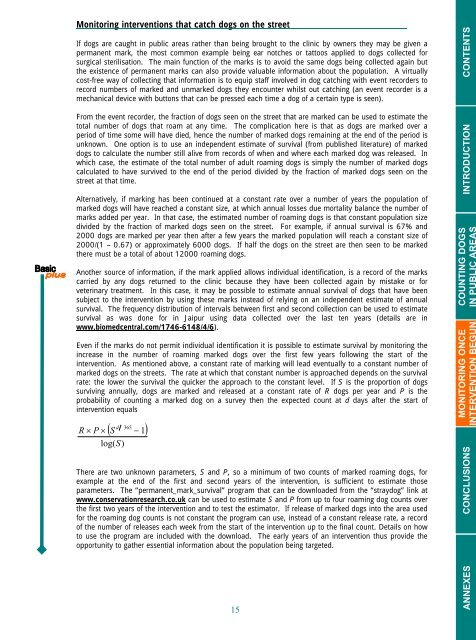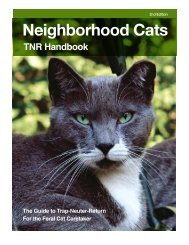Surveying roaming dog populations: guidelines ... - Animal Sheltering
Surveying roaming dog populations: guidelines ... - Animal Sheltering
Surveying roaming dog populations: guidelines ... - Animal Sheltering
You also want an ePaper? Increase the reach of your titles
YUMPU automatically turns print PDFs into web optimized ePapers that Google loves.
Monitoring interventions that catch <strong>dog</strong>s on the street<br />
If <strong>dog</strong>s are caught in public areas rather than being brought to the clinic by owners they may be given a<br />
permanent mark, the most common example being ear notches or tattoos applied to <strong>dog</strong>s collected for<br />
surgical sterilisation. The main function of the marks is to avoid the same <strong>dog</strong>s being collected again but<br />
the existence of permanent marks can also provide valuable information about the population. A virtually<br />
cost-free way of collecting that information is to equip staff involved in <strong>dog</strong> catching with event recorders to<br />
record numbers of marked and unmarked <strong>dog</strong>s they encounter whilst out catching (an event recorder is a<br />
mechanical device with buttons that can be pressed each time a <strong>dog</strong> of a certain type is seen).<br />
From the event recorder, the fraction of <strong>dog</strong>s seen on the street that are marked can be used to estimate the<br />
total number of <strong>dog</strong>s that roam at any time. The complication here is that as <strong>dog</strong>s are marked over a<br />
period of time some will have died, hence the number of marked <strong>dog</strong>s remaining at the end of the period is<br />
unknown. One option is to use an independent estimate of survival (from published literature) of marked<br />
<strong>dog</strong>s to calculate the number still alive from records of when and where each marked <strong>dog</strong> was released. In<br />
which case, the estimate of the total number of adult <strong>roaming</strong> <strong>dog</strong>s is simply the number of marked <strong>dog</strong>s<br />
calculated to have survived to the end of the period divided by the fraction of marked <strong>dog</strong>s seen on the<br />
street at that time.<br />
Alternatively, if marking has been continued at a constant rate over a number of years the population of<br />
marked <strong>dog</strong>s will have reached a constant size, at which annual losses due mortality balance the number of<br />
marks added per year. In that case, the estimated number of <strong>roaming</strong> <strong>dog</strong>s is that constant population size<br />
divided by the fraction of marked <strong>dog</strong>s seen on the street. For example, if annual survival is 67% and<br />
2000 <strong>dog</strong>s are marked per year then after a few years the marked population will reach a constant size of<br />
2000/(1 – 0.67) or approximately 6000 <strong>dog</strong>s. If half the <strong>dog</strong>s on the street are then seen to be marked<br />
there must be a total of about 12000 <strong>roaming</strong> <strong>dog</strong>s.<br />
Another source of information, if the mark applied allows individual identification, is a record of the marks<br />
carried by any <strong>dog</strong>s returned to the clinic because they have been collected again by mistake or for<br />
veterinary treatment. In this case, it may be possible to estimate annual survival of <strong>dog</strong>s that have been<br />
subject to the intervention by using these marks instead of relying on an independent estimate of annual<br />
survival. The frequency distribution of intervals between first and second collection can be used to estimate<br />
survival as was done for in Jaipur using data collected over the last ten years (details are in<br />
www.biomedcentral.com/1746-6148/4/6).<br />
Even if the marks do not permit individual identification it is possible to estimate survival by monitoring the<br />
increase in the number of <strong>roaming</strong> marked <strong>dog</strong>s over the first few years following the start of the<br />
intervention. As mentioned above, a constant rate of marking will lead eventually to a constant number of<br />
marked <strong>dog</strong>s on the streets. The rate at which that constant number is approached depends on the survival<br />
rate: the lower the survival the quicker the approach to the constant level. If S is the proportion of <strong>dog</strong>s<br />
surviving annually, <strong>dog</strong>s are marked and released at a constant rate of R <strong>dog</strong>s per year and P is the<br />
probability of counting a marked <strong>dog</strong> on a survey then the expected count at d days after the start of<br />
intervention equals<br />
R × P ×<br />
log( S)<br />
d 365<br />
( S − 1)<br />
There are two unknown parameters, S and P, so a minimum of two counts of marked <strong>roaming</strong> <strong>dog</strong>s, for<br />
example at the end of the first and second years of the intervention, is sufficient to estimate those<br />
parameters. The “permanent_mark_survival” program that can be downloaded from the “stray<strong>dog</strong>” link at<br />
www.conservationresearch.co.uk can be used to estimate S and P from up to four <strong>roaming</strong> <strong>dog</strong> counts over<br />
the first two years of the intervention and to test the estimator. If release of marked <strong>dog</strong>s into the area used<br />
for the <strong>roaming</strong> <strong>dog</strong> counts is not constant the program can use, instead of a constant release rate, a record<br />
of the number of releases each week from the start of the intervention up to the final count. Details on how<br />
to use the program are included with the download. The early years of an intervention thus provide the<br />
opportunity to gather essential information about the population being targeted.<br />
CONCLUSIONS<br />
MONITORING ONCE COUNTING DOGS<br />
INTRODUCTION<br />
CONTENTS<br />
15<br />
ANNEXES








